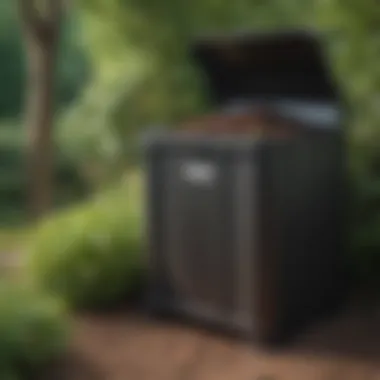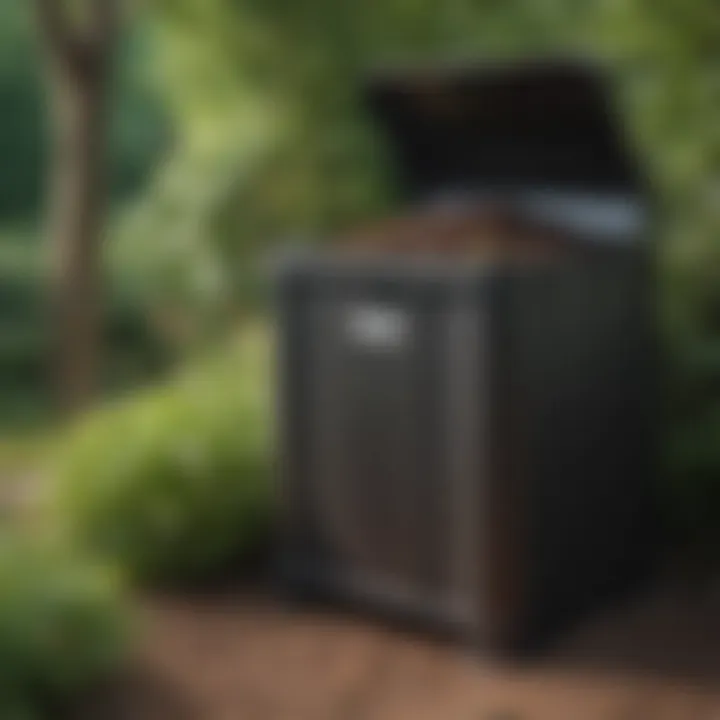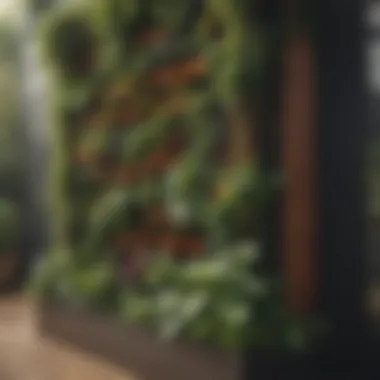Composting in Small Yards: Strategies for Success


Intro
Composting represents a sustainable practice that contributes positively to the environment while enriching gardens. For those with limited outdoor space, such as a small yard, effective composting methods can still be applied. This article will provide insights into various strategies and techniques specifically tailored for compact areas, ensuring that anyone, regardless of yard size, can participate in composting.
Benefits of Composting in Small Yards
One primary advantage of composting is waste reduction. By turning organic waste into nutrient-rich compost, individuals can minimize landfill contributions. An additional benefit includes the enhancement of soil quality. Compost boosts soil fertility, improves drainage, and promotes healthy plant growth. In a smaller yard, where plants may rely heavily on enriched soil, composting becomes essential.
Techniques for Small Space Composting
Various methods exist for composting in small areas. Understanding these options helps one choose an effective strategy that fits personal needs.
Bokashi Composting
Bokashi is an anaerobic composting method that utilizes a special bran containing effective microorganisms. This technique allows composting of food scraps, including meat and dairy, which are typically challenging to compost. The process occurs in a sealed container, limiting odors and taking up minimal space.
Vermicomposting
Using worms to break down organic material is another effective small yard composting technique. This method can be done indoors or outside and requires a bin specifically designed for worms. Red wigglers are the most common choice for this purpose. Vermicomposting generates nutrient-rich worm castings that enrich garden soil significantly.
Compost Tumblers
Compost tumblers provide an efficient way to create compost with limited space. These enclosed bins allow for easy aeration, which accelerates the composting process. Tumblers come in various sizes, making them suitable for small yards. They also help manage odors better than traditional compost piles.
Layered Composting
Layering materials is a fundamental strategy for composting. In a small space, layering helps balance green materials like kitchen scraps with brown materials such as dry leaves. This method maintains a healthy composting process without overwhelming limited spaces.
"Creating a system that works for your specific situation can lead to successful composting in any size yard."
Essential Materials for Composting
A thriving compost system requires specific materials for efficient breakdown.
Greens and Browns
Greens include nitrogen-rich materials like fruit and vegetable scraps or coffee grounds. Browns contain carbon, such as dry leaves, paper, and cardboard. Equal parts of greens and browns enable effective composting.
Moisture and Air
Proper moisture and aeration are crucial for composting. The compost should be damp, similar to a wrung-out sponge. Overly wet or dry compost may slow down decomposition. Turning the compost regularly promotes airflow, which encourages microbial activity.
Addressing Challenges
Small yards present unique challenges like limited space and odor management.
Space Restrictions
To maximize space, consider vertical composting solutions or smaller containers. Using shelves to stack compost bins can also optimize yard dimensions without sacrificing functionality.
Odor Control
Odor can become an issue with composting, particularly if materials are not balanced. Regularly turning the compost and ensuring an appropriate mix of greens and browns can mitigate bad smells. Additionally, Bokashi composting is advantageous as it minimizes odors associated with decaying waste.
The End
Understanding the nuances of composting in a small yard is crucial for achieving sustainability goals. With thoughtful strategies and techniques, any limited space can be transformed into a productive composting area. Cultivating this practice not only benefits individual gardens but also contributes to a healthier planet.
Understanding Composting
Composting is a practical and eco-friendly method of recycling organic waste into nutrient-rich fertilizer. In the context of small yards, it serves a dual purpose: it helps manage waste and enriches garden soil. Understanding composting is vital for anyone looking to enhance their gardening practices while also contributing to environmental sustainability. As urban spaces reduce in size, finding effective ways to utilize what little space is available becomes crucial.
Definition and Purpose
Composting can be defined as the process of breaking down organic materials, such as food scraps and yard waste, through natural decomposition facilitated by microorganisms and invertebrates. The purpose of composting extends beyond just waste management. It transforms waste into a valuable resource that improves soil health, which is particularly important in small yards where soil quality can be compromised.
By composting, one also reduces the amount of waste sent to landfills. According to the Environmental Protection Agency (EPA), about 30% of waste in landfills consists of organic materials that could be composted. This not only decreases landfill size but also reduces greenhouse gas emissions, making composting an essential aspect of sustainable living.
Environmental Impact
The environmental impact of composting is profound. Through composting, the cycle of organic material is completed, returning essential nutrients to the earth and reducing reliance on chemical fertilizers. Compost enhances soil structure, which improves water retention and aeration. This leads to healthier plants and less water usage.
Furthermore, composting helps to:
- Reduce Waste: Keeping organic materials out of landfills minimizes the amount of waste produced.
- Enrich Soil: Compost adds nutrients back into the soil, promoting plant growth.
- Lower Carbon Footprint: By composting, one reduces the energy used in waste transportation and processing.


"Composting is not just an act of recycling—it's a commitment to a more sustainable future."
Benefits of Composting in a Small Yard
Composting offers numerous advantages that can greatly benefit any small yard. The limited space often found in urban or suburban environments can present challenges for gardeners. However, composting provides efficient solutions to these challenges. The benefits go beyond just improving garden health; they impact the environment and provide economic savings. Understanding these benefits is crucial for anyone considering composting in a limited area.
Soil Enrichment
One of the primary benefits of composting is soil enrichment. Compost adds essential nutrients to the soil, enhancing its fertility. In gardens with restricted space, this is particularly important. Healthy soil leads to better plant growth, which is vital for small garden plots. Incorporating compost can improve soil structure, making it more porous. This helps with water retention and airflow to roots. Additionally, compost encourages beneficial microorganisms and earthworms, which further enrich the soil. When plants thrive, they produce better yields, making small gardens more productive.
Waste Reduction
Composting significantly reduces organic waste that would otherwise contribute to landfills. In small yards, this is an essential consideration. Every household generates waste, and rather than discarding it, composting offers a way to repurpose kitchen scraps and garden waste. This not only minimizes landfill contributions but also supports a circular economy. By composting, one can transform banana peels, eggshells, and other organic materials into valuable compost. This process might seem small but collectively, it makes a big impact on local waste management systems and promotes sustainability.
Cost Efficiency
Composting can also lead to substantial cost savings. Instead of purchasing chemical fertilizers, gardeners can use homemade compost to enrich their soil. This not only cuts costs but also eliminates the need for harsh chemicals, which can harm the environment. Additionally, many materials used in composting can easily be sourced from one’s own kitchen or yard. This practice reduces the dependency on commercial gardening products, making it economically beneficial in the long run. Overall, composting is a sustainable method that enhances gardening practices while providing economic advantages.
"Composting converts waste into a resource, enriching gardens while benefiting the environment."
Choosing the Right Composting Method
Selecting a suitable composting method is crucial for achieving effective results in a small yard. Different techniques cater to varying needs, space limitations, and personal preferences. Understanding these methods allows you to make informed choices that enhance composting efficiency and suit your lifestyle. By exploring each method's advantages and considerations, you can identify the best approach for your unique garden environment.
Traditional Composting
Traditional composting involves the natural decomposition of organic waste through microbial activity. It typically requires a compost pile or bin where materials are layered and managed over time. To begin with this method, ideal locations should be considered, as a well-placed compost bin can facilitate aeration and moisture retention.
Advantages:
Traditional composting is straightforward and can handle a diverse range of organic materials. Using kitchen scraps and yard waste, you effectively reduce landfill waste while producing nutrient-rich compost for your garden. It is cost-effective, as there are no special tools or materials needed beyond the compost bin itself.
Considerations:
One should manage the balance between green and brown materials to ensure proper decomposition. Green materials provide nitrogen, while brown materials offer carbon. In addition, regular turning of the compost is necessary to aerate the pile and promote quicker decomposition.
Vermicomposting
Vermicomposting, or worm composting, uses specific worms, typically red wigglers, to break down organic materials. This method is compact and suitable for small spaces, making it ideal for urban gardeners. A worm bin can be kept indoors or outdoors, allowing for flexibility in how composting is executed.
Advantages:
Vermicomposting produces a nutrient-dense byproduct known as worm castings, which is highly beneficial for plants. This method is also efficient, as worms can eat their weight in organic materials daily, accelerating compost production. Furthermore, the process generally produces little to no odor, making it a pleasant option for close quarters.
Considerations:
Worms require specific conditions to thrive, including proper moisture and temperature levels. The bin should not attract unwanted pests, which can happen if food scraps are improperly managed. Care must be taken to avoid adding materials that are harmful to worms.
Bokashi Composting
Bokashi composting is a fermentation process that uses beneficial microorganisms to break down organic waste. It can handle a wider variety of materials than traditional composting, including meat and dairy products, which are usually avoided in compost piles. A Bokashi bin is often used, where layers of waste and Bokashi bran, an inoculated mixture of wheat bran, are compacted together.
Advantages:
One significant advantage of Bokashi composting is its speed; the fermentation process occurs within days. This method also minimizes odors and facilitates the breakdown of diverse organic materials. Moreover, the pre-compost mixture can be buried in soil, enriching it directly while avoiding the lengthy decomposition process.
Considerations:
Users must be diligent in managing the moisture levels in the Bokashi bin to prevent mold and unwanted odors. After the fermentation process, the mixture must be buried promptly. Additionally, some gardeners might find the initial learning curve steep, as Bokashi requires specific techniques for optimal results.
Choosing the right composting method can significantly improve both the compost quality and the overall gardening experience. Understanding each technique's nuances is essential to achieving successful composting outcomes.
Selecting a Composting Container
Choosing the right composting container is a crucial step in establishing an effective composting system in a small yard. The container not only holds the materials you want to compost but also influences the efficiency of the composting process. Selecting an appropriate container can help manage odors, deter pests, and create a conducive environment for decomposition. In small spaces, where functionality and aesthetics intersect, the right choice becomes even more significant.
Options for Small Spaces
Several composting container options fit limited areas, each with distinct advantages:
- Tumbling Composter: These are closed bins mounted on a rotating axis. They allow easy mixing and aerating of materials without needing to manually turn the compost. Their compact size fits easily in small yards, and they can help speed up the decomposing process.
- Worm Bins: Ideal for indoor or outdoor use, these bins utilize red wigglers to break down kitchen scraps. For small areas, worm bins can be stylishly incorporated into your living space while providing nutrient-rich compost.
- Stackable Bins: Stackable systems permit flexibility in space use. They come as multi-bin units that allow the composting of different materials separately, making it easy to manage and monitor the process.
- Kitchen Scrap Bins: These small, portable containers can be kept in the kitchen for collecting waste before transferring it to the main compost bin. They typically have a lid to contain odors, which is especially vital when storing food scraps.
Selecting among these options should depend on your available space, the volume of waste you produce, and how involved you want to be in the maintenance of the composting system.
DIY Compost Bin Ideas
Crafting your own compost bin is not only cost-effective but also allows for personalization according to specific space requirements. Here are some ideas:
- Wood Pallet Bin: Upcycling wood pallets can create a rustic yet functional compost bin. Simply assemble four pallets into a square or rectangle, leaving the front open for easy access.
- Wire Mesh Bin: Using wire mesh, you can easily create a circular bin. The advantages include good airflow and visibility of composting materials. This is particularly useful for monitoring decomposition.
- Trash Can Composter: Convert a large plastic trash can into a compost bin by drilling several holes around the sides and bottom for aeration. This compact solution is ideal for tight spaces.
- Plastic Storage Bin: A basic plastic storage bin with a lid can serve as an affordable compost container. Drill holes for ventilation, and you're set for indoor or outdoor composting.
By selecting or creating a composter that matches your needs, you can effectively manage your backyard’s organic waste while contributing positively to the environment.
"A well-chosen composting container can streamline composting, making it efficient and manageable even in small yards."
Essential Compost Materials
Understanding the essential materials used in composting is crucial for successfully creating nutrient-rich soil. In small yard composting, the correct balance of materials can maximize efficiency and minimize issues. The essential compost materials are generally categorized into two groups: green materials and brown materials. Both of these categories play important roles in the composting process, and knowing what to include can significantly enhance the quality of compost.
Green Materials


Green materials are rich in nitrogen and provide moisture to the compost pile. These items are typically fresh, lush, and are often considered 'soft' components. Examples of green materials include:
- Kitchen scraps like vegetable peels, fruit cores, and coffee grounds.
- Fresh grass clippings from mowing your lawn.
- Plant trimmings and other garden waste.
Using a healthy amount of green materials helps in accelerating the decomposition process and adds valuable nutrients to the soil. When added correctly, they contribute to a lively microbial environment that enriches compost quality. However, too much of this material can lead to odors, so balancing it with brown materials is essential.
Brown Materials
Brown materials, conversely, are high in carbon, offering a different set of benefits. They are often dry and 'hard' components found in nature. Some typical examples of brown materials include:
- Dried leaves collected in the fall.
- Straw or hay from local farms.
- Cardboard and paper products (non-glossy).
The presence of brown materials is vital as they help aerate the compost and control moisture levels. They also add structural integrity to the compost pile. Having a good ratio of brown to green materials, typically around 2:1, can prevent compaction and facilitate better airflow, which is necessary for composting to progress effectively.
Avoiding Contaminants
It is equally important to understand what to avoid when selecting compost materials. Certain contaminants can negatively affect both the composting process and the final product. Avoid adding:
- Meat, dairy, or oily foods, as they attract pests and create odors.
- Diseased plants, which can transfer pathogens to your compost.
- Inorganic materials like plastics, metals, or treated wood, which do not decompose and may leach harmful chemicals.
By carefully selecting your compost materials and steering clear of potential contaminants, you can ensure a successful composting process that yields high-quality compost, ready to nourish your garden. For detailed guidance on materials and methods, consider checking resources like Wikipedia or Britannica.
Remember, balancing green and brown materials while avoiding contaminants is fundamental in creating a thriving compost system within your small yard.
Maintaining Your Compost System
Maintaining a compost system is crucial for ensuring that it functions efficiently and produces high-quality compost. Proper maintenance not only accelerates decomposition but also minimizes unpleasant odors and potential pest problems. In a small yard, where space is limited, careful management of compost becomes even more significant. Regular attention to moisture, aeration, and temperature can make a big difference, resulting in a thriving compost environment that benefits your garden and contributes to waste reduction.
Moisture Management
Moisture plays a critical role in the composting process. A compost pile requires a balance of wet and dry materials, which often directly influences its ability to decompose efficiently. If the compost is too dry, microbial activity slows down, and decomposition may practically stop. On the other hand, excessive moisture can create anaerobic conditions, leading to foul odors and attracting pests.
Maintaining ideal moisture levels is a continuous task. Aim for a moisture content similar to that of a damp sponge. You can monitor moisture by squeezing a handful of compost; if water drips out, it is too wet. If only a few drops come out, it may need more water. To manage moisture:
- Add green materials, such as grass clippings or kitchen scraps, to increase moisture content.
- Incorporate brown materials like dry leaves or straw to absorb excess moisture.
- Turn the compost regularly to mix the materials and help them retain moisture evenly.
Regular Turning
Regular turning of the compost pile is essential for promoting aeration and speeding up the decomposition process. By breaking up clumps and exposing inner materials to air, you enhance the conditions for aerobic bacteria to thrive. These microorganisms are critical for breaking down organic materials efficiently.
Turning your compost every few weeks not only facilitates aeration but also helps distribute moisture throughout the pile. Additionally, it can offer a good opportunity to inspect your compost for any signs of trouble. While turning:
- Check for a uniform texture. Uneven consistency may indicate that some areas are too wet or too dry.
- Look for any surrounding pests. If you observe signs of unwanted visitors, address them at this time.
Using a pitchfork or compost aerator can simplify this process while ensuring that you maintain the proper structure and balance within your compost pile.
Temperature Monitoring
Temperature is a key indicator of the composting process’s health. A well-functioning compost pile can reach temperatures between 130°F to 160°F, which is ideal for breaking down materials and destroying pathogens or weed seeds. Monitoring temperature will help you assess the effectiveness of your maintenance efforts.
To check the temperature, insert a compost thermometer into the center of the pile. If the temperature rises above 160°F, it may be beneficial to turn the compost more frequently to prevent overheating, which can kill beneficial organisms. A drop in temperature below 130°F could indicate that decomposition is slowing, often due to insufficient moisture or a lack of aeration.
- Use the following guidelines for temperature monitoring:
- Adjust moisture as needed based on temperature readings.
- Turn materials more often if high temperatures persist.
- On noticing a cooling, evaluate the compost components and add more greens if necessary.
Properly maintaining your compost system is fundamental to producing a rich, nutritious amendment for your garden.
By paying attention to moisture management, regular turning, and temperature monitoring, you can create an effective composting system even in limited spaces. Consistent, mindful maintenance will ensure that your compost serves its purpose and supports your gardening efforts.
Troubleshooting Common Issues
When engaging in composting within a small yard, challenges can arise. Properly addressing these challenges is essential for maintaining an effective compost system. This section discusses common problems: odors, pests, and slow decomposition. Each issue requires attention and understanding, ensuring that your composting journey is successful and efficient.
Odor Problems
Odor issues are common in composting. They often indicate an imbalance in the compost materials. A healthy compost pile should have a neutral smell. If you notice a foul smell, it might be due to excess moisture or too many green materials, like kitchen scraps.
To remedy odor problems:
- Aerate the compost: Turn the pile to introduce oxygen. This can help eliminate odors.
- Balance materials: Mix in brown materials, such as dried leaves or cardboard, to offset the green materials.
- Monitor moisture levels: The compost should feel damp but not soggy. If it is too wet, add dry materials to absorb excess moisture.
"A well-maintained compost system should be smell-free, promoting a healthy environment for breakdown processes."
Pest Management


Pests can be a real concern for those composting in small spaces. Rodents and insects may be attracted to food scraps. Hence, proper pest management is crucial.
To keep pests at bay:
- Use a secure bin: A compost bin with a lid can deter animals.
- Avoid meat and fatty foods: These attract pests. Stick to vegetable scraps and yard waste.
- Introduce beneficial insects: Predators like ladybugs can help manage harmful pests naturally.
Slow Decomposition
Slow decomposition can frustrate composter. Factors like lack of moisture, lack of air, or an improper mix of materials often cause this issue.
To speed up decomposition:
- Optimize the carbon-to-nitrogen ratio: Aim for a balance. A mix of 30 parts carbon to 1 part nitrogen is ideal.
- Increase aeration: Regularly turning your compost helps introduce air.
- Monitor moisture levels: Keep it damp to promote microbial activity, which accelerates breakdown.
Using Compost in Your Garden
Using compost in your garden is a significant aspect of both sustainable gardening and waste management. Compost enriches soil quality, improves drainage, and promotes the growth of healthy plants. When incorporating compost, gardeners tap into a natural resource that enhances the ecosystem and reduces dependence on chemical fertilizers.
Compost serves as a slow-release organic fertilizer, which means it nourishes plants over time. This gradual feed minimizes the risk of nutrient leaching and ensures that essential minerals are available to plants as needed, rather than all at once. The use of compost supports beneficial microorganisms in the soil, leading to increased biodiversity. As this microbial activity thrives, so do your plants, fostering robust root systems that help withstand environmental stresses.
Application Techniques
Applying compost correctly can maximize its benefits. Here are some effective techniques you can use:
- Top Dressing: Spread a layer of compost over the soil surface around your plants. This method not only supplies nutrients but also helps retain moisture.
- Mixing into Soil: Before planting, work compost into the soil to enrich it. This method ensures that nutrients are readily accessible for new plants.
- Compost Tea: Steep compost in water to create a nutrient-rich liquid feed that you can apply directly to plants. This method offers an easy way to deliver nutrients quickly.
- Mulching: Use compost as mulch around plants. This practice helps suppress weeds and maintain soil temperature.
Timing for Usage
The timing of compost application plays a crucial role in maximizing its effectiveness. Consider the following guidelines:
- Spring Preparation: Early spring is ideal for incorporating compost into garden beds. This provides nutrients as plants begin their growth cycle.
- Post-Harvest: After the harvest season, apply compost to rejuvenate the soil. This adds nutrients back into the soil, preparing it for future crops.
- During Planting: Apply compost while planting new seeds or transplants. This gives young plants a nutrient boost right from the start.
Adding compost at the right times promotes healthy plant development, resulting in a better yield.
"By enhancing the soil with compost, you create a thriving environment for plants that nurtures both their growth and the surrounding ecosystem."
Compacting Composting Beyond the Yard
In urban and suburban settings, space can often be a limiting factor for individuals looking to engage in composting. The trend towards compacting composting practices beyond one's immediate yard resonates strongly with people eager to contribute to environmental health while navigating these constraints. This section explores how composting can extend beyond the confines of personal property, fostering community engagement and promoting sustainable practices.
Community Composting Programs
Community composting programs are essential for small yard composters who face space limitations. These programs often operate in shared spaces, such as community gardens or parks, providing residents a collective area to compost organic waste. For those interested in sustainability, joining such programs can deepen their environmental impact.
In these settings, community members can contribute kitchen scraps, yard waste, and other compostable materials. It allows for larger-scale composting that may be unmanageable in a small yard. This shared responsibility not only helps in more efficient composting but also builds a sense of community, connecting people through shared goals.
Benefits of participating in community composting include:
- Access to resources: Participants often receive guidance on composting best practices, reducing the learning curve for beginners.
- Reduction of waste: Collectively, the community can divert significant amounts of organic waste from landfills.
- Enriched soil: The resulting compost can be shared among members for gardening or community projects, enriching local soil and boosting plant health.
Online Resources and Support
In addition to local community efforts, various online resources exist to support individuals interested in composting beyond their yards. Websites such as reddit.com and en.wikipedia.org offer forums and articles that share practical advice, troubleshooting tips, and experiences from fellow composters. These platforms create a space for discussion and learning, forming valuable networks that transcend geographical constraints.
Social media platforms like Facebook also host groups where members share their composting journeys, ask questions, and exchange compost. This accessibility ensures that no one has to navigate composting alone.
Some areas to explore within online resources include:
- Tutorials and webinars: Many organizations now offer free or low-cost online workshops to educate about composting techniques.
- E-books and articles: Comprehensive guides available online cover everything from basic composting principles to advanced methods.
- Local initiatives: Following local composting initiatives on social media can inform individuals about upcoming events or learning opportunities within their community.
By harnessing both community involvement and online resources, individuals can effectively manage their composting efforts, extending its benefits beyond small yards. Each method reinforces the idea that composting does not just belong to one's backyard; rather, it can be an engaging, communal effort that fosters sustainability and environmental consciousness.
The Future of Composting
Composting stands as a vital practice, playing a critical role in sustainable gardening and waste management. The future of composting is likely to involve modern innovations that create more efficient, user-friendly systems. While traditional composting remains foundational, advancements in technology and changes in societal policies can significantly enhance effectiveness.
Technological Innovations
Technological advancements are reshaping composting practices. The integration of smart technology into composting systems offers great promise. Smart composting bins now exist, featuring sensors that monitor temperature, moisture, and aeration. These bins can alert the user when adjustments are needed, thus promoting efficient decomposition.
Moreover, mobile applications are emerging as effective tools for composting management. These apps provide users with guidance on the optimal composting materials, methods, and maintenance schedules. They can even allow for tracking progress, making composting more approachable for beginners.
In addition, advancements in microbial additives can speed up the decomposition process. These specially formulated products help improve the breaking down of organic materials. As a result, users can expect to produce high-quality compost faster while also minimizing odor issues.
Policy Developments
Policy is another significant factor in shaping the future of composting. Governments around the world are recognizing the importance of composting in reducing landfill waste and promoting sustainability. Legislative support is growing, with many regions implementing composting regulations that encourage households and businesses to compost their organic waste.
For example, some municipalities provide incentives for residents to install composting systems. This initiative often includes financial subsidies or rebates for purchasing compost bins. These policies not only promote community-wide composting efforts, but they also educate citizens on waste reduction strategies.
Furthermore, broader policies focusing on waste management increasingly include composting as a central strategy. Educational programs and resources often aim to inform the public about how to compost effectively, highlighting its crucial role in environmental sustainability.
Important Note: The proactive engagement of local governments and community organizations enhances public interest in composting. As awareness grows, more individuals will realize the impact of their actions on the environment.













